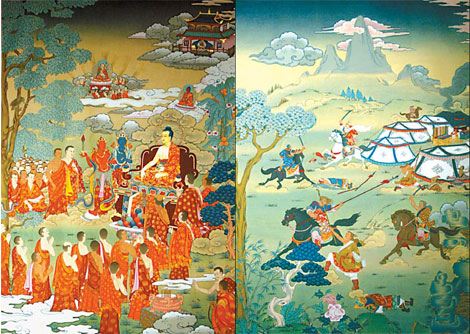King Gesar returns to enlighten Olympic visitors
 0 Comment(s)
0 Comment(s) Print
Print E-mail
China Daily, August 5, 2008
E-mail
China Daily, August 5, 2008
 |
|
An ongoing Thangka painting exhibition in Beijing depicts the legend of King Gesar. Photos by Zhang Wei |
Tibetan artist Namgyal has devoted nearly half his life to the traditional art of Thangka. The 26-year-old, who began practicing the age-old Buddhist banner art when he was 14, is paying his first visit to Beijing, where he will stay until late August.
Although he has left his Tibetan hometown of Kangding, in Sichuan province, to travel to the Olympic city for his first time, he has not come to watch the Beijing Games.
Instead, he, along with some 100 plus Tibetan artists and trained guides who speak Tibetan, Mandarin and English, will welcome visitors from around the world to a grand exhibition about Tibetan culture at the Cultural Palace of Nationalities in downtown Beijing.
"I hope visitors will like the exhibition and go to visit my hometown," he says.
The exhibition presents hundreds of Thangka paintings portraying stories of the central epic poem of Tibet, The Epic of King Gesar.
Handed down by generations of ballad singers in Sichuan, Yunnan, Tibet, Qinghai, Xinjiang and Inner Mongolia over 1,000 years, The Epic of King Gesar is considered one of the world's longest epics - containing 20 million plus words in more than one million verses. It tells how the half-human, half-god Tibetan king conquered the devils of other tribes and sought to help ordinary people.
Visitors will be able to see Namgyal and other Tibetan artists paint in the exhibition hall and watch live performances by artists from the Garze Tibetan Song and Dance Troupe from Sichuan.
Also on the program is Ani, a renowned Tibetan artist from Derge, in Garze Tibetan autonomous prefecture, in Sichuan province. Clad in traditional costume, Ani will sing songs from The Epic of King Gesar.
The 270 Thangka paintings on display have been selected from the King Gesar Epic Thangka Painting Series, which has a total of 1,288 works created by over 200 Tibetan researchers and Thangka painters over the past decade. The collection was listed as an intangible cultural heritage under State protection in 2007.
Go to Forum >>0 Comment(s)